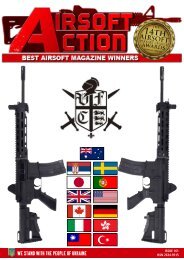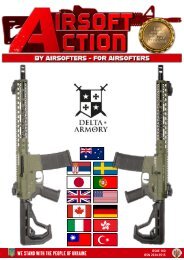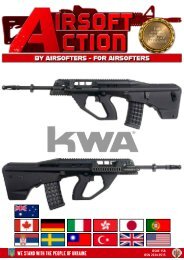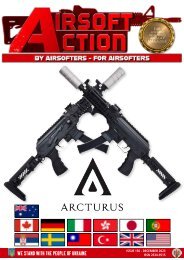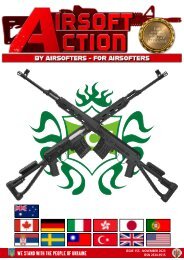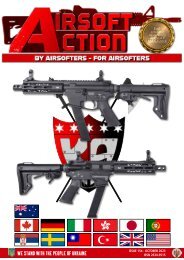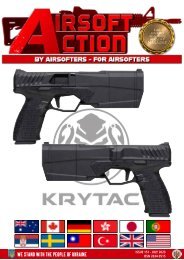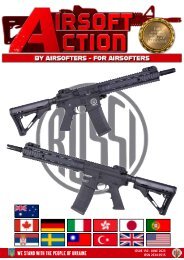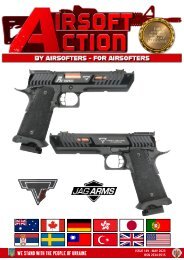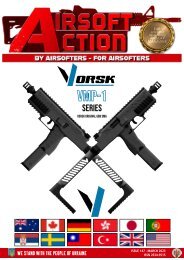PMCI - March - 2020
2020 has definitely started with all boots on the ground as the entire PMCI team made their way to SHOT Show to check out the latest and greatest at the biggest shooting show on the planet, and you can read the report in this issue! We've also got to grips with the SIG M400, the rather special Spartan Harsey Dagger, and the latest 6mm gas training "AR" from VFC, so whatever your "tool of choice", you can read about it in PMCI!
2020 has definitely started with all boots on the ground as the entire PMCI team made their way to SHOT Show to check out the latest and greatest at the biggest shooting show on the planet, and you can read the report in this issue! We've also got to grips with the SIG M400, the rather special Spartan Harsey Dagger, and the latest 6mm gas training "AR" from VFC, so whatever your "tool of choice", you can read about it in PMCI!
Create successful ePaper yourself
Turn your PDF publications into a flip-book with our unique Google optimized e-Paper software.
lightweight snubbies is to afford an effective level of firepower
in a package that is reliable, simple to operate, and easy to
carry.” Not only did experienced Law Enforcement officers carry
them but many in the Military Special Operations community I
have had the honor of meeting over the years did so as well.
To the modern nay-sayers sitting in gun shops, who
complain these little revolvers can’t be shot accurately, this
is where their ignorance truly shows. I have personally seen
these gentlemen with aging eyes peer through coke bottle
glasses and burn down center mass hits one after another
before walking off with the only perfect qualification scores. Is
it easy to shoot these little wheel guns accurately? Hell NO, but
it can be done?
YES, I’ve seen it happen year after year throughout my
career. It simply takes something a lot of shooters these days
who simply want to “go fast” don’t have; heart, determination
and dedication to practice enough to achieve their goal. With
that in mind, this week’s review article honors these fine
gentlemen with a look at an updated version of their best kept
secret, the Smith and Wesson model 638 Airweight double
action revolver.
FIRST IMPRESSIONS
The model featured is a variation of the classic model 638
Bodyguard many detectives and security specialists have
carried for decades. What makes this model different isn’t its
“humpback” frame shared by its predecessor and other S&W
hammerless designed revolvers such as the 642 and 442
but the fact that it features a very low profile, semi-bobbed
hammer. This hammer includes a small snag-free thumb stud
with just enough grip to firmly cock the hammer into single
action mode for a lighter trigger and more precise shot.
Visually, this gun as often looked at as the ugly duckling
of the Smith and Wesson line up compared to the classic look
of the larger model 66 Combat, but for those who understand
its design, the model 638 is gorgeous! This pistol features a
lightweight allow frame with a stainless steel barrel and
cylinder and only weights 14.6 oz! From its extreme furthest
ends, the gun measures 6.3” with a 1.785” barrel. The sight
radius consisting of a fixed front ramped sight and rear notch
style sight is roughly 3.4”. Despite the gun’s small dimensions,
the 638 is fully rated for +P ammunition. With the right
ammunition, that can amount to a lot of power in a small,
lightweight package able to be carried just about anywhere on
the body comfortably all day.
To carry the model 638 daily, I chose carry using a Gun Sox
ankle holster sent over for testing by Cheata Tactical (www.
cheatatactical.com) and a Safariland model 18 inside the
waistband holster loaned to me by good friend and fellow gun
writer, Clint Steele. When wearing jeans or khakis, the Gun
Sox’s full calf coverage would give me a perfect way to keep
the gun secure are readily accessible. During this time of year, a
pair of shorts end up being the attire for the day when I am not
teaching on the range or filming. For carrying concealed during
causal hours, the Safariland holster offered a great option for
appendix carry as well as at the 3 and 4 o’clock positions.
SPECS
Caliber: .38 Special
Weight: 14.6 oz.
Barrel Length: 1.785”
Overall Length: 6.3”
Overall Height: 4.5”
Rated: P+
Finish: Matte Grey
Grips: Black Rubber (Optional Pink)
Sights: Fixed
Trigger Pull: 4 lbs. (Single Action), 14 lbs. (Double Action)
RANGE TIME
To put the model 638 Airweight through the paces, I met with
fellow gun writers, Clint Steele and Jerry Moody at our local
private range known as “The Swamp”. For testing, I brought
along four different loads consisting of Winchester 110 grain
Jacketed Hollow Points (JHP), Corbon +P 110 JHP, Winchester
Bonded 130 grain JHP and 130 grain Full Metal Jacket (FMJ)
from American Eagle. Once the cameras and targets were set
up, each shooter took turns running each of the different loads
through the pistol. These tests would illustrate various felt
recoil and performance.
Working at common self-defense distances of 3 yards out to
15 yards, the 638 gave each shooter solid vital zone hits shooting
from the double action mode. More precise shots to the head
of the target could be taken by thumb cocking the hammer
manually in single action mode to reduce the trigger pull from
14 lbs. to a more manageable 4 lbs. All ammo performed well,
with the point of aim and point of impact matching up well
with the fixed sights. Of the four loads, the +P Corbon 110 JHP
ammo really stood out as far as felt recoil. Despite the slim but
comfortable black rubber grips, I could feel a sharp snap in my
hand as each round was fired. For regular practice, I stuck with
the American Eagle FMJ rounds and conceal carried the pistol
with the Winchester Bonded 130 grain JHP for better results on
soft targets.
Since I normally carry semi-auto pistols daily, loading was
the only aspect of testing the pistol I really needed to brush my
skills on. Despite knowing how to do it with my eyes closed
and even teaching it to others in classes, it still takes a small
learning curve to get everything flowing smoothly. The model
638 fit in my hands very well, allowing my short sausage
digits to manipulate the cylinder release and shrouded ejector
rod quickly. Most of the spent brass fell out cleanly with only
gravity pulling on it while I had the gun tilted back. Only the
Corbon casings needed an extra punch to clear their chambers.
What I noticed the most during slow fire was there seemed
to be a slight glitch when pulling the trigger. It was heavy and
smooth until the cylinder made its rotation then I would feel
a slight stop or “hitch” point before the hammer dropped. If I
manipulated the trigger pull just right, I could stop the hammer
very close to its natural single action cocked position before
continuing pressure to fire. After a morning of shooting, the 14
lbs. trigger pull really started to wear on my finger a bit as well.
Another point of interest that arose, came about when I
SMITH AND WESSON 638 AIRWEIGHT




